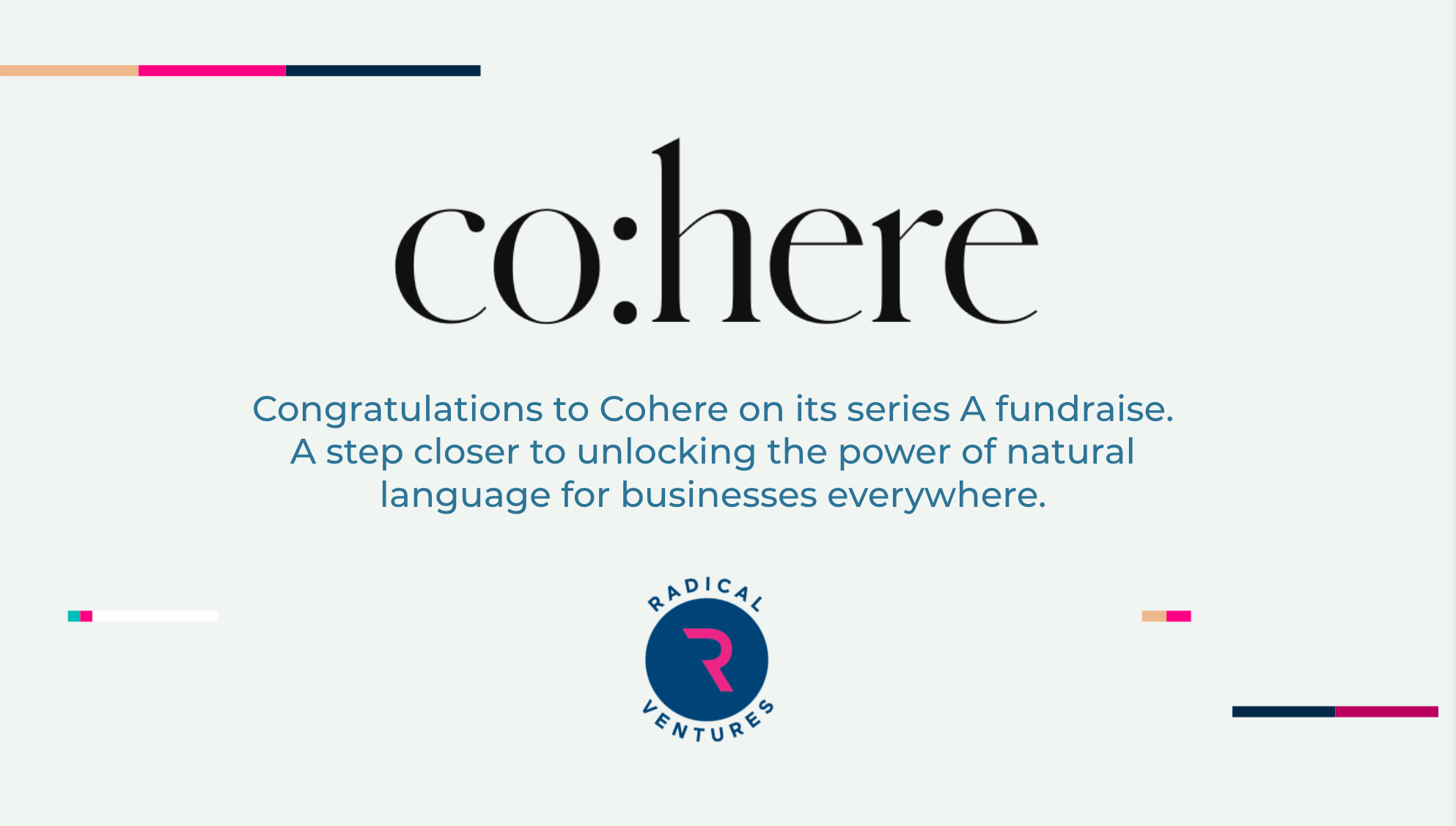In May, Radical Ventures portfolio company Cohere emerged from stealth with a mission to enable machines to understand the world and to make their software platform safely accessible to all. This week, we announce our continued commitment to Cohere as part of their $40 million Series A led by Index Ventures with participation from Section 32. Other investors include a who’s who of global AI luminaries, including Turing Award winner Geoffrey Hinton, Fei-Fei Li, Raquel Urtasun, Pieter Abbeel, and Sanja Fidler, among others.
Cohere is comprised of an incredibly talented team founded by two former Google Brain researchers and a founding engineer of Cortex. Aidan Gomez, Cohere’s co-founder and CEO, co-authored the breakthrough paper that pioneered Transformer architecture. The NLP models at the core of Cohere’s offering lead the industry in their versatility, with the ability to comprehend, compare and compose sophisticated text and continuously improve their training data.
Language is humanity’s greatest innovation. It is the primary method of communication between humans. For companies, language is the key to understanding their business and customers. Humanity’s second greatest innovation? Arguably digital machines, along with the infrastructure they are built on and the software that runs them. Much of the modern world is built on a digital backbone. And yet, machine understanding of human language remains in its infancy.
Until now, high-quality NLP models, such as GPT-3, have been the domain of the largest technology companies with bottomless resources. Massive scale is required to run modern NLP and the costs of training models, and collecting training data, runs in the millions of dollars for each model.
With this raise, the Cohere team is a step closer to bringing the vast potential of NLP to every business. We believe Cohere is uniquely positioned to become the leading platform in the dynamic NLP space. Our friend Geoffrey Hinton put it best: “The team at Cohere is building technology that will make this revolution in natural language understanding much more widely available.”
AI News This Week
-
The geography of AI: Which cities will drive the AI revolution? (Brookings)
AI is a crucial technology impacting economic competitiveness and national growth. While this is an analysis of AI strengths across the United States, (on page 21) the research report discusses Toronto’s Vector Institute for AI, co-founded by Radical Ventures Managing Partner Jordan Jacobs amongst others, calling it “one of the most ambitious efforts in North America to upgrade a strong ecosystem into a world-class position.” The report finds that AI is still an emergent industry geographically concentrated in superstar aggregation areas and early adopter hubs.
-
A smart receipt company that’s capturing the big banks’ attention (Globe and Mail – subscription required)
Radical Ventures portfolio company Sensibill discusses the new fintech frontier using AI to produce a differentiated customer experience. Radical Investor Adithya Sreekumar notes that providers like Sensibill help banks play catch-up to customer expectations which have been defined by on-demand and personalized technologies.
-
Edge computing: Resource-efficient inference for particle physics (Nature)
Selecting interesting proton–proton collisions from the 40 million taking place each second in the Large Hadron Collider (LHC) is a challenging task. The LHC collides particles at ultra-high energies to allow scientists to observe the outcome in its mammoth detectors and make discoveries about space and time and the microstructure of matter. The resulting ‘events,’ where an event is the record of the thousands of particles emerging from one collision, need to be filtered very quickly. Only the most interesting events will go to the next stage for further filtering. A neural network optimized for a field-programmable gate array (FPGA) hardware enables 60 nanosecond inference and reduces power consumption by a factor of 50.
-
Using machine learning to help track bolides (really bright meteors) (SETI Institute)
A team under NASA’s Asteroid Threat Assessment Project (ATAP) is using machine learning to spot fireballs in the sky called bolides. These incredibly bright flashes of light are emitted when a large meteoroid or asteroid enters Earth’s atmosphere and explodes. While it is extremely unlikely (it might be a once in a 50,000-year event) there is the potential for a significant asteroid strike to do devastating damage (think dinosaurs). By detecting and tracking a significant number of bolides, it will be possible to develop models to predict where and how asteroids will enter Earth’s atmosphere and assess the risk.
-
What makes an artist in the age of algorithms? (Wired)
Grammy-nominated composer of 2010’s These Hopeful Machines, BT, argues that art is a form of big data and discusses his new composition that lives on the blockchain. From the rise of NFTs to the proliferation of techno-artists who use generative adversarial networks (GANs) to produce visual expressions, to smartphone apps that write new music, creatives and technologists are continually experimenting with how art is produced, consumed, and monetized.
Radical Reads is edited by Ebin Tomy (Analyst, Radical Ventures)

